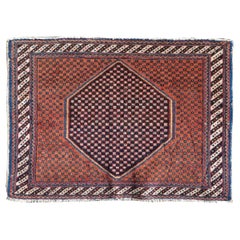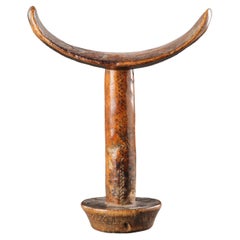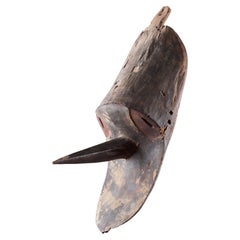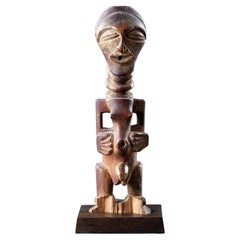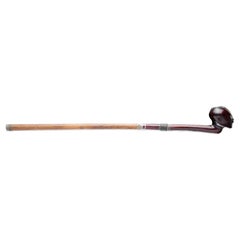Tribal Art
234
to
27
108
104
234
234
234
5
1
51
183
990
34
382
384
69
8
1
15
21
20
31
26
15
14
5
115
57
37
24
19
91
79
67
25
23
4
4
1
1
1
Tribal Art For Sale
Period: 19th Century
Period: 18th Century and Earlier
Antique Persian Afshar Bagface, c. 1900
Located in San Francisco, CA
Antique Persian Afshar Bagface Bag, c. 1900
This highly graphic Afshar bag face draws a large central indigo-blue hexagon against a complimentary contrasting terra cotta field. Both...
Category
19th Century Persian Antique Tribal Art
Materials
Wool
Red Afshar Sumak Salt Bag, Late 19th Century
Located in San Francisco, CA
Red Afshar Sumak Salt Bag, Late 19th Century
A central white diamond is highlighted in white cotton on this Afshar salt bag. Throughout the field, geometric scarab-like elements ar...
Category
Late 19th Century Persian Antique Tribal Art
Materials
Wool
A Finely Carved ‘Boni’ Neck-Rest
Located in London, GB
A Finely Carved ‘Boni’ Neck-Rest
Superb dark colour and patination through extended use
Wood
Somalia
19th Century
SIZE: 18.5cm high, 15.5cm wide - 7¼ ins high, 6 ins wide
These hea...
Category
19th Century Antique Tribal Art
Materials
Wood
A Rare Spirit Mask ‘Barak’ or ‘Yamburai Parak’
Located in London, GB
A Rare Spirit Mask ‘Barak’ or ‘Yamburai Parak’
Wood, remains of polychrome
Eastern Sepik Province, New Guinea
Late 19th - early 20th Century
SIZE: 45cm high, 35cm deep - 17¾ ins hig...
Category
Late 19th Century Papua New Guinean Antique Tribal Art
Materials
Wood
A Songye Male ‘Power’ Figure
Located in London, GB
A Songye Male ‘Power’ Figure
Open aperture to the head and stomach
Fine overall patina, loss to feet
Democratic Republic of Congo
19th Century
Size: 23cm high - 9 ins high
The ...
Category
19th Century Congolese Antique Tribal Art
Materials
Wood
An Exceptional Eastern Cape Nguni Pipe Bowl and Stem
Located in London, GB
An Exceptional Eastern Cape Nguni Pipe Bowl and Stem
Wood, metal
Old inscription and dated: ‘1892’
South Africa
19th Century
Size: 45.5cm long - 18 ins long
Published:
‘The ...
Category
19th Century South African Antique Tribal Art
Materials
Wood
An Extremely Fine South African Tsonga Prestige Staff by the ‘Baboon Master'
Located in London, GB
A Rare and Extremely Fine South African Tsonga Prestige Staff by the ‘Baboon Master’
Depicting a Zulu elder wearing a head-ring
Superb silky reddish brown patina
Late 19th Century ...
Category
Late 19th Century South African Antique Tribal Art
Materials
Wood
A Rare Wood Ear Ornament
Located in London, GB
A Rare Wood Ear Ornament
With old collectors label ‘Ear Wood. Paraquay’
Wood
Paraguay
19th Century
Size: 6cm dia., 3.5cm deep - 2¼ ins dia., 1¼ ins deep
Published:
Steven Phe...
Category
19th Century Paraguayan Antique Tribal Art
Materials
Wood
A South Eastern Congo, Zaire Songye Protective Fetish Figure ‘Nkishi’ of Geometr
Located in London, GB
A South Eastern Congo, Zaire Songye Protective Fetish Figure ‘Nkishi’ of Geometric Form the arms placed to the side
A plug of fetish material in the head cavity a strip of old hide a...
Category
19th Century Congolese Antique Tribal Art
Materials
Wood
Framed Collection of Twenty-One Native American Arrowheads
Located in Chicago, IL
An exceptional set of twenty-one stone arrowheads, discovered in Wisconsin's Waukesha County and framed within a 19th-century faux grain painted shadowbox, these arrowheads not only ...
Category
15th Century and Earlier American Native American Antique Tribal Art
Materials
Stone
A Fine and Rare Shona Knife and Sheath
Located in London, GB
A Fine and Rare Shona Knife and Sheath
Wood, steel, copper
Fine colour and patina
Zimabawe / Africa
19th Century
Size: 48cm long - 19 ins long (with scabbard)
42.5cm l...
Category
19th Century Zimbabwean Antique Tribal Art
Materials
Copper, Steel
An Exceptional New Zealand Māori Bugle-Flute ‘Pu Turino’
Located in London, GB
An Exceptional New Zealand Māori Bugle-Flute ‘Pu Turino’
With soft and shallow surface decoration profusely carved with a dynamic scrolling motif made of two sections bound together ...
Category
18th Century New Zealand Antique Tribal Art
Materials
Wood
A Rare Double Roll of Pacific Solomon Islands, Santa Cruz, Red Feather Currency
Located in London, GB
A Rare Double Roll of Pacific Solomon Islands, Santa Cruz, Red Feather Currency ‘Tevau’
Plant fibre, bark strips, red bird feathers, small shells, glass beads
Solomon Islands
...
Category
19th Century Solomon Islands Antique Tribal Art
Materials
Feathers
An Unusual Polynesian ‘Child’s’ Fighting Club
Located in London, GB
An Unusual Polynesian ‘Child’s’ Fighting Club
Old patina and mellow colour
Wood
Fiji
19th Century
SIZE: 84.5cm long - 33¼ ins longù
Provenance:
Ex Welsh collection, sold at au...
Category
19th Century Fijian Antique Tribal Art
Materials
Wood
An Unusual ‘Kanak’ Hardwood War Club
Located in London, GB
An Unusual ‘Kanak’ Hardwood War Club
Fine dark glossy patina from use, a lighter band where a now lost ‘binding’ would have acted also as a ‘wrist thong’
Wood
New Caledonian, Kanak
E...
Category
Early 19th Century New Caledonian Antique Tribal Art
Materials
Wood
A wooden statue Siraha Salawa nobel Nias Ancestor Figure Indonesia
Located in Chonburi, TH
This wooden statue from Siraha Salawa, a noble Nias ancestor figure from Indonesia, is a striking example of Nias artistry and cultural heritage. Carved from a single piece of wood, ...
Category
19th Century Indonesian Antique Tribal Art
Materials
Wood
Ubangian Female Statue Late 19th Century
Located in London, GB
Female Ubangian statue in carved wood represented standing, the body of anthropomorphic type and zoomorphic head. Late 19th Century. Good patina. Past estorations.
Provenance : Pri...
Category
Late 19th Century African Antique Tribal Art
Materials
Wood
Marroquin Arab 1870 Koummya Dagger With Sheath In Wood Silver And Brass
Located in Miami, FL
Marroquin forged steel dagger with sheath.
Beautiful koummya dagger with a sheath from the region of Morocco, circa 1870. The blade was created with forged steel, mounted in wood an...
Category
1870s Moroccan Islamic Antique Tribal Art
Materials
Silver, Sterling Silver, Brass, Steel
Late 19th-Early 20th Century Tribal Mask, West Nepal
Located in Point Richmond, CA
Late 19th-early 20th century Tribal mask, West Nepal
A mask from West Nepal with a sharp straight nose, squinting eyes and a square mouth showing upper and lower teeth. There are re...
Category
Late 19th Century Nepalese Tribal Antique Tribal Art
Materials
Wood
Late 19th-Early 20th Century Tribal Mask, West Nepal
Located in Point Richmond, CA
Late 19th-early 20th century Tribal mask, West Nepal
A mask from West Nepal with slanted almond shaped eyes, very small ears and an oval mouth showing carved upper and lower teeth o...
Category
Late 19th Century Nepalese Tribal Antique Tribal Art
Materials
Wood
Ancient Indus Valley cup bearer Fertility figurine C (2800-2600 BC).
Located in London, GB
Ancient Indus Valley cup bearer Fertility figurine Circa (2800-2600 BC).
A rare female pottery cup bearer figurine in terracotta with pointed facial features and applied diamond sha...
Category
15th Century and Earlier Indian Antique Tribal Art
Materials
Terracotta
Fine Antique Japanese woven copper box basket Asian Antiques Ikebana 中国古董
Located in London, GB
A fine a rare Japanese box masterly woven in copper, the box with lid and handles
dates to 19th century Meiji Period, and it imitates the Ikebana bamboo basketry style
Height 17...
Category
19th Century Japanese Antique Tribal Art
Materials
Copper
Superb Antique Yemeni Saudi Arabian Khanjar Jambiya Dagger Silver Islamic Arts
Located in London, GB
A Rare Large Antique Jambiya Dagger with highly ornate silver work with added gold gilding
A superb example of a middle eastern Jambiya
Height 3...
Category
Late 19th Century Yemeni Antique Tribal Art
Materials
Silver, Gold Leaf
Pre Columbian Costa Rican Jadeite Axe God pendant
Located in London, GB
A Pre Columbian Jadeite Axe God pendant from the Guanacaste/Nicoya region of Costa Rica Circa. 800 to 1200 AD.
The axe god pendant of highly stylized Human form drilled through the ...
Category
15th Century and Earlier Costa Rican Antique Tribal Art
Materials
Pottery
Late 19th-Early 20th Century Tribal Mask, West Nepal
Located in Point Richmond, CA
Late 19th-early 20th century Tribal mask, West Nepal
A large mask from West Nepal with a small grin and bared teeth surrounded with pink powder, faint traces of which can also be se...
Category
Late 19th Century Nepalese Tribal Antique Tribal Art
Materials
Wood
Late 19th-Early 20th Century Tribal Mask, West Nepal
Located in Point Richmond, CA
Late 19th-early 20th century Tribal mask, West Nepal
A mask from West Nepal with a rather heart shaped facial plane. There are three large iron staples, two of which may have secure...
Category
Late 19th Century Nepalese Tribal Antique Tribal Art
Materials
Wood
Shell Plaque (Barava) from Solomon Islands, 19th Century
Located in NICE, FR
Objects crafted from the shell of the giant Tridacna clam, also known as the fossilized giant clam, held great value among numerous Melanesian peoples. The artistry of working with f...
Category
19th Century Solomon Islands Tribal Antique Tribal Art
Materials
Shell
Nomoli - Carved Stone Figurine, Kissi People, Sierra Leone, 19th Century
Located in Aramits, Nouvelle-Aquitaine
A Nomoli is a carved stone figurine native to Sierra Leone and Liberia. They are usually made of soapstone, limestone, or granite.
The carving depicts a man holding his belly with a...
Category
19th Century Sierra Leonean Tribal Antique Tribal Art
Materials
Stone, Soapstone
Bronze Currency Bangle/Manilla, Oromo People, Burkina Faso, Ethiopia, 19th C.
Located in Aramits, Nouvelle-Aquitaine
19th-century bronze currency bangle / Manilla with a fixed opening. Minimalist, simple design work with engraved geometrical circles and lines.
This type of bracelet was used and wor...
Category
Mid-19th Century Ethiopian Tribal Antique Tribal Art
Materials
Bronze
Nomoli - Carved Stone Figurine, Kissi People, Sierra Leone, 19th Century
Located in Aramits, Nouvelle-Aquitaine
A Nomoli is a carved stone figurine native to Sierra Leone and Liberia. They are usually made of soapstone, limestone, or granite.
The carving depicts a woman in a dress and choker,...
Category
19th Century Sierra Leonean Tribal Antique Tribal Art
Materials
Stone, Soapstone
Grouping of 5 Manillas, Okpoho, Nigeria, 19th Century
Located in Aramits, Nouvelle-Aquitaine
Manillas are horse-shoe shaped, made of an open circle of bronze, brass, or copper with enlarged finial terminations. They were used as a currency in West African countries from the ...
Category
Mid-19th Century Nigerian Tribal Antique Tribal Art
Materials
Bronze, Brass, Copper
Ere Ibeji Pair of Commemorative Figures, Oyo, Yoruba People Nigeria, late 19th C
Located in Aramits, Nouvelle-Aquitaine
Yoruba people have one of the highest incidents of twin births in the world. As a result, twin children are regarded as extraordinary, divine beings protected by Sango, the deity of ...
Category
1890s Nigerian Tribal Antique Tribal Art
Materials
Wood
Bronze Currency Bracelet/Manilla, Dogon People, Burkina Faso, 19th c. - No 5
Located in Aramits, Nouvelle-Aquitaine
19th-century bronze currency bracelet / Manilla in horseshoe form with fixed opening. Intricate graphical swirled rope work design and tips are shaped with large flat ends with geome...
Category
Mid-19th Century Burkinabe Tribal Antique Tribal Art
Materials
Bronze
Bronze Currency Bracelet/Manilla, Dogon People, Burkina Faso, 19th c. - No 2
Located in Aramits, Nouvelle-Aquitaine
19th-century bronze currency bracelet / Manilla in horseshoe form with fixed opening. Intricate graphical design with lines and accent points on the top and at both tips. This type o...
Category
Mid-19th Century Burkinabe Tribal Antique Tribal Art
Materials
Brass
Bronze Currency Bracelet/Manilla, Dogon People, Burkina Faso, 19th c. - No 3
Located in Aramits, Nouvelle-Aquitaine
19th-century bronze currency bracelet / Manilla in horseshoe form with fixed opening. Intricate graphical design with a lattice pattern. This type of bracelet was worn or used by the...
Category
Mid-19th Century Burkinabe Tribal Antique Tribal Art
Materials
Bronze
Pre Columbian Narino Carchi Coquero Coca chewer Figure Columbia
Located in London, GB
A hand modelled statue of a male coca chewer figure , known as a Coquero, wearing a sash sitting upon a bench, the coca quid in his right cheek, with black negative resist design
Pr...
Category
15th Century and Earlier Colombian Antique Tribal Art
Materials
Pottery
Bronze Currency Bracelet/Manilla, Dogon People, Burkina Faso, 19th c. - No 4
Located in Aramits, Nouvelle-Aquitaine
19th-century bronze currency bracelet / Manilla in horseshoe form with fixed opening. Intricate graphical swirl design and tips are shaped with large flat ends with cross pattern des...
Category
Mid-19th Century Burkinabe Tribal Antique Tribal Art
Materials
Bronze
Bronze Currency Bracelet/Manilla, Dogon People, Burkina Faso, 19th Century
Located in Aramits, Nouvelle-Aquitaine
19th-century bronze currency bracelet / Manilla in horseshoe form with fixed opening. Intricate graphical swirl design and tips are shaped with large flat ends with 5 beads on each s...
Category
Mid-19th Century Burkinabe Tribal Antique Tribal Art
Materials
Brass
Pre Columbian Colima Dog Ancient West Mexico Latin American Antiques Art
Located in London, GB
Pre Columbian Colima Dog Ancient West Mexico
Pre-Columbian, West Mexico, Colima Ancient Mexico C 200 BC –400 AD
A attractive seated Colima dog v...
Category
15th Century and Earlier Mexican Antique Tribal Art
Materials
Pottery
Pre Columbian Maya Polychrome Pottery Bowl circa A.D. 550-950
Located in London, GB
Maya Poly-chrome painted pottery bowl
Guatemala/ central America late Classic period, circa A.D. 550-950,
A bowl of rounded bottom circular form, painted with a frieze of monkey...
Category
15th Century and Earlier Guatemalan Antique Tribal Art
Materials
Pottery
Bronze Currency Bracelet/Manilla, Beri People, Sudan, 19th Century - No 1
Located in Aramits, Nouvelle-Aquitaine
Early to mid-19th-century bronze currency bracelet / Manilla in circle form. Intricate graphical geometrical. This type of bracelet was worn/used by the Zaghawa People also called Bé...
Category
Mid-19th Century Sudanese Tribal Antique Tribal Art
Materials
Bronze
Bronze Currency Bracelet/Manilla, Beri People, Sudan, 19th Century - No 2
Located in Aramits, Nouvelle-Aquitaine
Early to mid-19th-century bronze currency bracelet / Manilla in circle form. Intricate graphical geometrical. This type of bracelet was worn/used by the Zaghawa People also called Bé...
Category
Mid-19th Century Sudanese Tribal Antique Tribal Art
Materials
Bronze
Antique Leggings 1880s Southern Arapaho Plains Native American Hide Fringe Beads
Located in Denver, CO
Museum quality Southern Arapaho (Hinono’ei) Native American Plains Indian leggings circa 1880s. Constructed of dyed native tanned hide with viridian green dye and ochre yellow embel...
Category
Late 19th Century American Native American Antique Tribal Art
Materials
Hide, Beads
African Tribal Art Fine Zulu Neck Rest Head Rest South Africa
Located in London, GB
A fine Zulu head rest neck rest South Africa
Raised on central pillars with geometric lozenge shaped carving all over.
Measures: 22 x 14 x 5 cm approx.
Period Early 20th century
Ex U...
Category
19th Century Zimbabwean Antique Tribal Art
Materials
Wood
Ancient Nomadic Belts
Located in Alessandria, Piemonte
Ancient nomadic belts, covered with embroidery and ancient coins.
Purchased by a young oriental man in a European market.
they can also be used as blinds for curtains.
nr. 1 - cm. 5...
Category
Late 19th Century Afghan Other Antique Tribal Art
Materials
Cotton
19th Century Iron African Currency Blade
Located in Vancouver, BC
Wonderful object with arrow shaped blades. Beautiful decorative with complex and fascinating history;
Iron currency tokens are among the most compelling and virtuosic of sub-Sahara...
Category
Late 19th Century African Antique Tribal Art
Materials
Iron
A Very Rare Long Maori Paddle ‘Hoe’
Located in London, GB
A Very Rare Long Maori Paddle ‘Hoe’
Superb colour and patina
Wood
Maori / New Zealand
Late 18th / early 19th Century
Size: 217cm long - 85½ ins long
Provenance:
W.D. Webster, B...
Category
Late 18th Century New Zealand Antique Tribal Art
Materials
Wood
Pre Columbian Large Inca Early Colonial period Wood Kero South American Antiques
Located in London, GB
Large Pre Columbian INCA / Early Colonial period Wood Kero
A superb Large Inca Kero cup profusely carved in the mosaic style with a image of the Inca or...
Category
15th Century and Earlier Peruvian Antique Tribal Art
Materials
Wood
Ancient Fiji Islands Flat Serving Bowl or Platter 19th century Polynesia
Located in Point Richmond, CA
Ancient Fiji Islands Flat Serving Bowl or Platter 19th century, made of very dense hardwood with deep patina, and expected wear on bottom. Two small opposing holes for suspension.
B...
Category
Late 19th Century Fijian Tribal Antique Tribal Art
Materials
Wood
extremely rare Algerian Judaica silver, jewish Dowry box early 19th century
Located in Tel Aviv - Jaffa, IL
Amazing and scarce JUDAICA object, we have here one of the most touching jewish objects we had for a long time, this small silver dowry box was made in Algeria in the early 19th century, it is all covered with symbols of jewish faith and of couples, the sliding lid has 2 flanking birds with hamsa (protective hand) on each side and a flower vase in the middle.
one side shows two flanking lions with a tree in the middle and the other side shows again two big and two small birds with a flower bowl in the middle, front side has a key hole and next to it there is the Hebrew inscription ס״ט״" which says Siman tov or in English "a good sign" it is taken from the wedding blessing, underneath the lock there is another inscription with the name ״עזיזה בת אברהם בן חמו״ which is the name of the bride, her father and her grandfathers name.
the box is full marked a lot of times with the silversmith mark, every side of the box is marked.
this box was probably ordered by the grooms family to hold the jewelry they are giving to the bride as dowry, this type of objects are rare and there are just a few of them on museum collections.
DOWRY (Heb. נְדֻנְיָה), the property a wife brings to her husband at marriage; the Yiddish equivalent, nadn, is from the same root. The custom of nedunyah became clearly defined and institutionalized only in the talmudic period. In biblical times, mohar (מֹהַר), whereby the groom bought his wife from her father (Gen. 24:53; Ex. 22:15–16; Hos. 3:2), was the accepted practice. It was then customary that the groom give the bride gifts, and that she bring certain property to her husband's home upon marriage: slaves, cattle, real estate, etc. (cf. Gen. 24:59–61; 29; Judg. 1:14ff.; I Kings 9:16). Evidence of the custom of nedunyah is to be found in Tobit (7:14; 8:21) and in the Assuan papyri (Cowley, Aramaic, nos. 15, 18). Gradually, mohar was superseded by the ketubbah custom according to which the husband merely assumed the responsibility of compensation to his wife in case he divorced her: he had to pay her 200 zuzim if she had been a virgin at the time of marriage, and 100 zuzim if a widow or divorcée (see *Ketubbah).
By talmudic times, the institution of nedunyah was prevalent; the father gave a dowry to the bride since the daughter was excluded from paternal inheritance. Fifty zuzim (equivalent to the worth of 180 grams of silver) was the minimum amount a father was obliged to give to his daughter (Ket. 6:5). Parents usually gave much more, according to their social standing. Community funds provided the dowry for an orphan or a very poor girl (ibid.; cf. Sh. Ar., YD 251:8). In case of her father's death, the brothers of a minor girl were obliged to give her the minimum dowry, and the court estimated how much her father would have given her above the minimum dowry. The sum was then taken out of the father's estate and given to the daughter upon majority (Ket. 6:6; 68a–69b). In the absence of such an estimate, each daughter was entitled to receive one-tenth of the value of her father's estate in money, or in valuables (Yad, Ishut, 20:4–7; Sh. Ar., EH 113:4). If the father was unable or unwilling to pay the promised dowry at the betrothal ceremony, the groom could refuse to marry his bride (Ket. 13:5; Ket. 108b–109a). Insistence on exact payment of the promised dowry, however, was frowned upon by later rabbinic authorities (Rema to Sh. Ar., EH 2:1). In certain communities it was customary for the groom's father to make a dowry contribution equal to that of the bride's father (Ket. 102b). The dowry, whether given in real estate, slaves, money, or chattel was recorded in the marriage contract (the ketubbah) and in some instances one-third or one-fifth of the actual value of the dowry was added to the sum mentioned in the ketubbah. Based upon a decree enacted by *Simeon b. Shetah (first century C.E.), the Talmud ruled that the husband and his entire property were liable for compensation as stipulated in the ketubbah, either in case he died (when she collected the sum specified in the ketubbah from the heirs) or in case he divorced his wife (Ket. 82b). For the status of the dowry and the husband's rights and obligations, see below. The rabbinic enactments (Takkanot Shum) by R. Jacob *Tam and by the rabbinic synod of the communities of Speyer, Worms, and Mainz (Germany) stipulated that if a woman died...
Category
Mid-19th Century Algerian Antique Tribal Art
Materials
Silver
A Nias 'Adu Zatua' wooden ancestor sculpture
Located in Amsterdam, NL
Indonesia, Nias, 19th century
H. 37.5 x W. 10 cm
Sculptures like the one present are not only decorative items but are believed to be vessels that house the spirits of ancestors and are used to communicate with them.
After the death of a person a wooden image or Adu Zatua was made to mediate between the human world and the spiritual realm. These kinds of figures were commissioned by noble Nias families, whereas simple and lesser quality carvings generally were found among lower class families.
In this particularly fine example, the sculptor has paid careful attention to the proportions of the different parts of the body, dividing it into three main sections – the head, the torso, and the legs. The shapes are sometimes flat, round, or have notches, but all are perfectly in balance creating a certain divine tranquillity. This Adua Zatua’s ears are decorated with earrings, and it is wearing a headdress, pointing towards a chiefly provenance.
In 1914 the Dutch gained complete control of the island of Nias and started spreading Protestant Christianity. Many ancestor statues...
Category
19th Century Indonesian Antique Tribal Art
Materials
Wood
Moroccan Berber Wooden Sugar Hammer Marteau a Sucre Deggaga
Located in North Hollywood, CA
Moroccan Berber hand-carved wooden sugar hammer "Deggaga".
Handcrafted by the Berber women of Morocco, hand-carved and hand painted wood with tribal desig...
Category
Early 19th Century Moroccan Islamic Antique Tribal Art
Materials
Wood
19th Century Bronze Coin with Silver Bezel Earrings by Jewels
Located in Point Richmond, CA
19th Century Bronze Coin with Silver Bezel Earrings by Jewels of Santa Fe/Marrakesh
A pair of earrings made by Jewels with bronze coins from Morocco and Egypt set in silver bezels a...
Category
19th Century Moroccan Tribal Antique Tribal Art
Materials
Silver, Bronze
Two Pre Inuit Thule Culture Bone Tool Handles
Located in Bridgeport, CT
Two carved bone tool Handles from the Pre-Inuit Thule Culture in all original condition. Probable wood working tools, the handles once held Stone or, more rarely, Iron blades. The la...
Category
17th Century Tribal Antique Tribal Art
Materials
Bone
18th Century Bronze Palanquin Leopard Finials
Located in West Palm Beach, FL
18th Century Bronze Palanquin Leopard Finials
An intriguing pair of 18th-century Bronze Palanquin Leopard Finials, exquisite artifacts that represent the opulence and cultural herit...
Category
18th Century Indian Tribal Antique Tribal Art
Materials
Bronze
Antique Rugs Blue Caucasian Kazak Rugs, Geometric Carpet Livingroom Rug
Located in Hampshire, GB
Kazak rugs have primarily been produced as village productions rather than city pieces. Made from materials particular to individual tribal provinces and the rugs of the Caucasus typically display bold geometric designs in primary colours. Kazak rugs are a type of Armenian rug...
Category
Late 19th Century Caucasian Kazak Antique Tribal Art
Materials
Natural Fiber, Organic Material, Wool
A Rare and Finely Carved Egyptian Wooden Headrest
Located in London, GB
A Rare and Finely Carved Egyptian Wooden Headrest with a Carved Head to both Sides Representing the God ‘Bes’ (Protector of the Homestead) above Carved...
Category
15th Century and Earlier Egyptian Antique Tribal Art
Materials
Wood
A Rare and Historically Important Artefact Recovered from HMS Adventure in 1775
Located in London, GB
A Rare and Historically Important Artefact Recovered from HMS Adventure in 1775 after Captain James Cook’s Second Voyage to the Pacific
A ‘coconut husker’ made by a ship’s carpenter aboard HMS Adventure in the style and design of a Native Islander’s ethnographical ‘coconut husker’
An engraved and inscribed copper plaque:
A memento from
The Sandwich Islands
Coconut Husker used aboard
HMS Adventure
and recovered from
The Royal Dockyard Deptford
1775
Oak, iron, brass, copper, handmade iron screws
Fine rich colour and patina
England / Sandwich Island
18th Century
SIZE: 15.5cm high, 49.5cm long, 20cm wide (max) - 6¹⁄₈ ins high, 19½ ins long, 7⁷⁄₈ ins wide (max)
Provenance:
Found in a Scottish attic after centuries of lying hidden in a crate
Ex Private Scottish collection
Captain James Cook’s second voyage aboard the Resolution and accompanied by HMS Adventure set sail in July 1772. The discovery of the southern eight islands of the Sandwich Islands group was in 1775. The given name was chosen in honour of John Montagu, 4th Earl of Sandwich, First Lord of the Admiralty.
The copper plaque and inscription however should not be read as The Sandwich Islands ‘Owhyhee’ (The Hawaiian Islands) which were later discovered on January 18th, 1778, on Captain Cook’s third voyage. Rather the inscription refers to ‘South Sandwich Islands’ lying to the south east of South Georgia and only renamed later with the word ‘South’ to distinguish them from the ‘Sandwich Islands’ now known as the Hawaiian Islands.
Not withstanding during Cook’s second voyage he visited Easter Island, Tahiti, Society Islands, Niue, Tonga, New Hebrides, New Caledonia, Norfolk Islands, Palmerston Island and South Georgia. The crew onboard having been exposed to various types of ‘coconut huskers’ adapted those designs into the example we now see, having been rescued from HMS Adventure in 1775. A rare example of 18th century cross...
Category
16th Century American Antique Tribal Art
Materials
Brass, Copper, Iron
